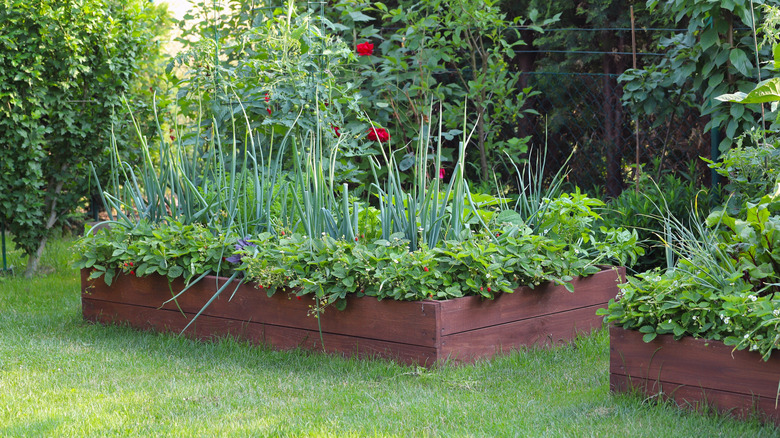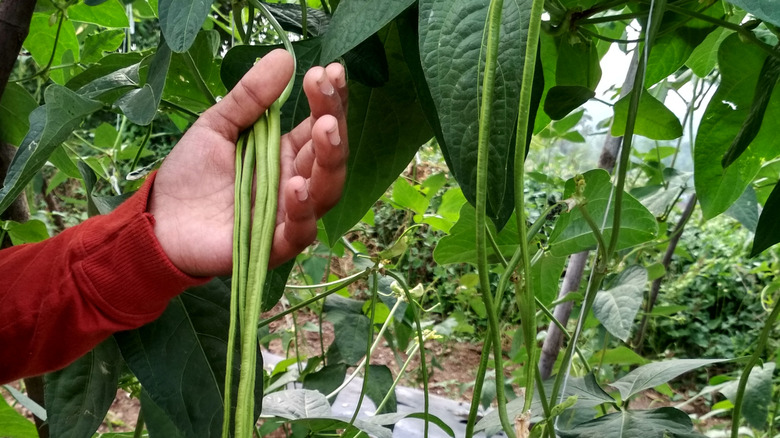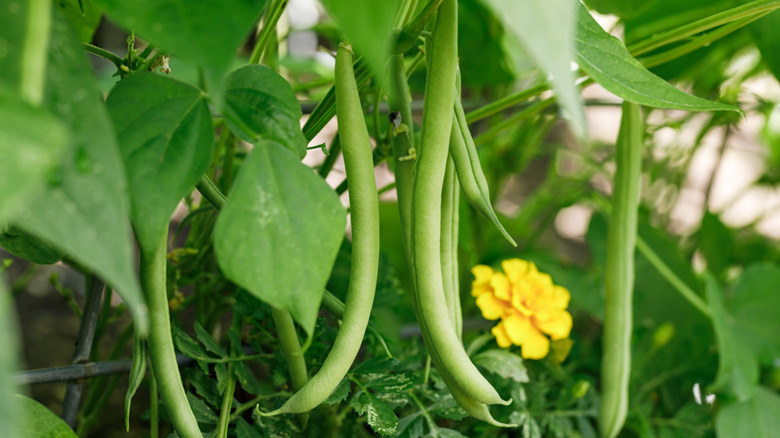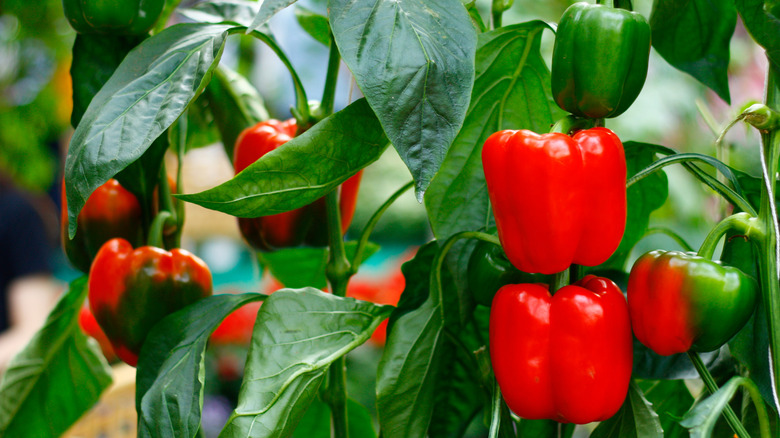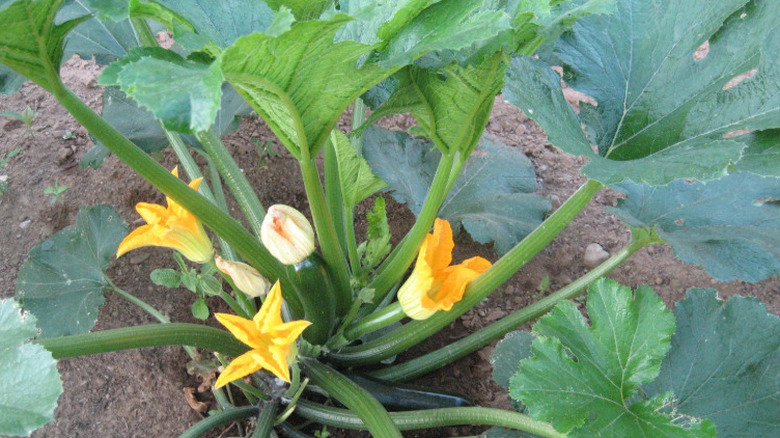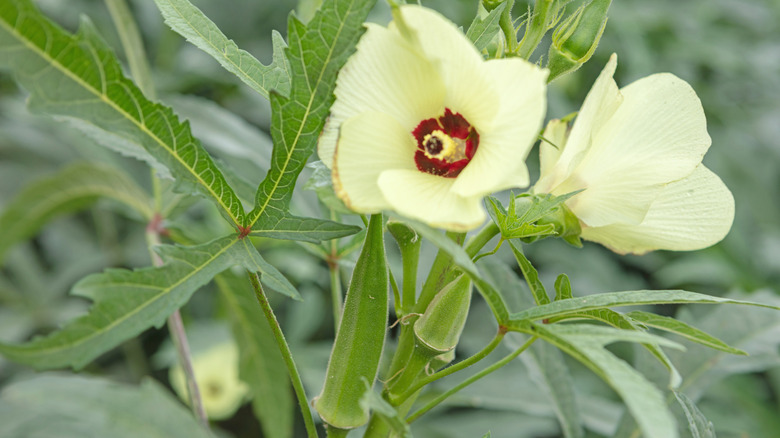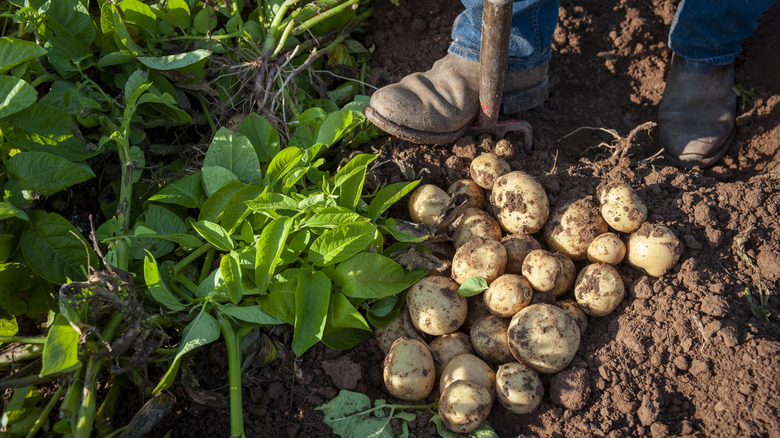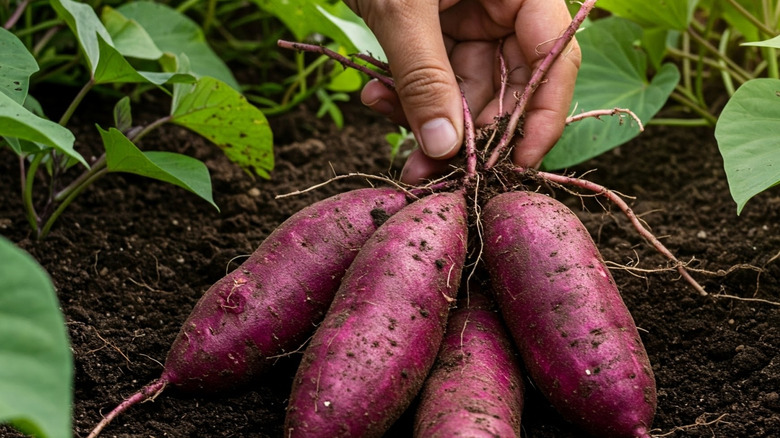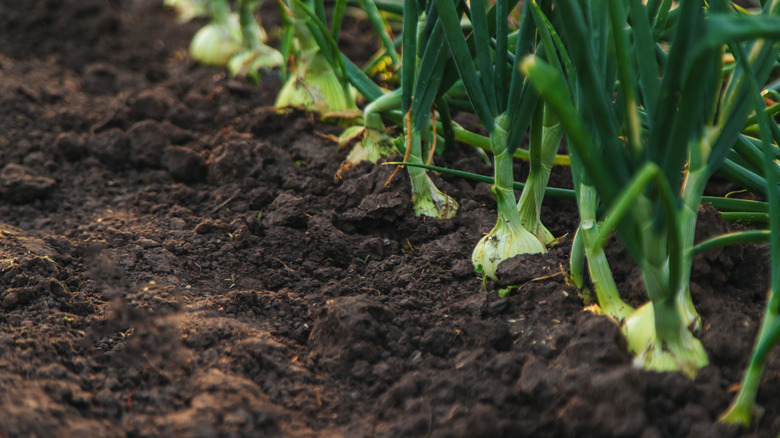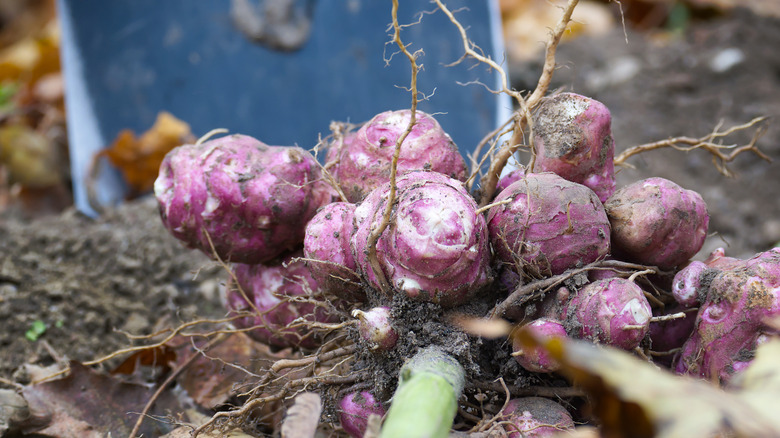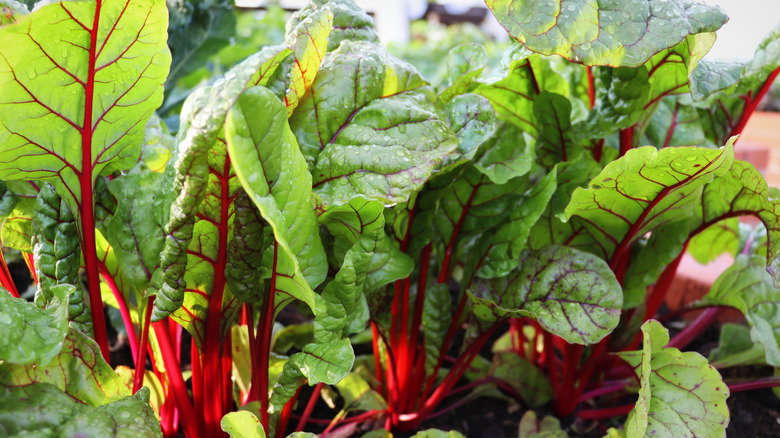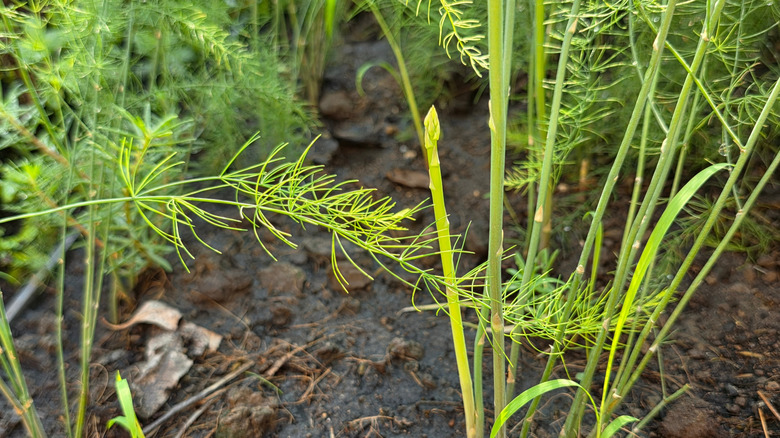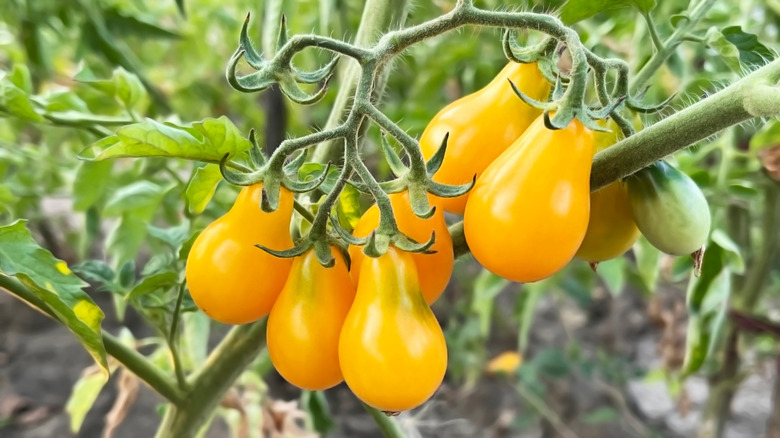12 Popular Vegetables That Don't Need Frequent Watering To Thrive In The Garden
When planning a vegetable garden, you probably focus primarily on improving the soil by adding lots of compost and setting up some type of watering system to ensure your crops are well hydrated. But did you know that there are popular vegetable varieties that actually don't need frequent watering to thrive in the garden, especially once they've become well-established? While all vegetables will need some water during their growth, there are popular root crops like potatoes and onions that will benefit from less water once the tubers and bulbs have formed. There are also deep-rooted vegetables, such as some tomato varieties, peppers (especially chili ones), and beans, that only need irrigating once a week.
Many of the deeper-rooted vegetables have the ability to search deep down below the soil surface for any available moisture. This means that they'll continue to thrive even when the top of the soil is dry. Other varieties that produce tubers, like sweet potatoes, can hold moisture within these fleshy parts to sustain their growth. You can also waterproof your crops to some degree by applying lots of mulch with products like straw. Plus, clever watering methods, like installing a drip system, can help you reduce your water usage. It's also a good idea to familiarize yourself with the best time of day to water your vegetable garden so the moisture doesn't evaporate too quickly and your plants continue to flourish.
Black-eyed peas
If you live anywhere in the south of the country, you're probably familiar with black-eyed peas, or southern peas, as they're also commonly known. These are hardy legumes that are quite drought-tolerant; however, it's a good idea to cover the soil around these plants with a good layer of mulch to help retain as much moisture as possible. You will find that if you give these plants an abundance of water, it will actually reduce their growth, making them perfect for a water-wise veggie patch.
Snap beans
Thanks to their short growing season, snap beans can grow and produce lots of those lovely, crisp pods without an excessive amount of water. You'll find that if you've amended your soil and it's relatively water-retentive, then your beans can survive on rainwater alone, unless you're going through an extended dry spell. Nevertheless, even if you have to water, make sure you aim it directly at the soil and give your plants a good soaking around once or twice a week. All they really need is an inch of water per week.
Peppers
Like snap beans, bell peppers need around an inch of water per week. They'll do especially well if you cover the soil around their shallow root system with plenty of thick mulch to prevent evaporation and then just give them a good soaking weekly during dry weather. The most crucial time for watering is when they're flowering and setting fruit. On the other hand, chili peppers are native to South America, so they're bred to withstand drier conditions, and you'll find that there's a whole range of spicy peppers you can grow in your garden.
'Dark Star' zucchini
There's one particular zucchini cultivar known as 'Dark Star' that has been bred to grow in drier conditions. It has deep roots to search for moisture in the soil. You'll love the slender, uniform fruits on this variety that are a glossy, deep green in color with exceptional flavor. The plant also has a lovely open growth habit, which makes it easy to spot the fruit rather than having to search for it under those large leaves. This is one of those vegetables you can plant in the middle of summer and still get a good crop.
Okra
If you've never grown okra before, the first thing that will surprise you is those pretty hibiscus-like blooms. That's because this vegetable is part of the mallow family. This plant is considered relatively drought-tolerant and only requires around 1 to 1.5 inches of water every seven to 10 days. This means that you'll only have to provide it with supplementary watering during dry weather periods. However, you should pay particular attention during flowering and fruit set. This is another plant that will really benefit from a good layer of mulch to help conserve soil moisture.
Potatoes
Potatoes are another vegetable crop that only needs around an inch of water per week, and generally only while the upper parts of the plants are actively growing. Along with many of the other more water-wise vegetable varieties, applying plenty of mulch around your potato plants will help to conserve soil moisture. These plants should only need supplementary watering if there has been no rainfall for a week or two. Once the plants have flowered and the tops are starting to decline, the tubers will have formed, and no additional water will be needed.
Sweet potatoes
If you experience a long growing season, sweet potatoes are a rewarding crop to grow. They only really need around an inch of water per week, which means they can survive on rainfall alone, unless you're experiencing an extended dry spell. However, it's important to note that you should provide your plants with extra moisture at the transplant stage, so the roots can establish themselves quickly. Once your tubers are nearing harvest time, you should avoid watering the plants altogether so that the tubers don't split from excessive moisture in the soil.
Onions
Like many other root crops already mentioned, onions only need around an inch of water every week or so while their green leaves are actively growing. These plants will also benefit from decent mulching to maintain some of the soil moisture, and a deep soaking early in the morning once a week is better than a daily sprinkle. Once you notice that the bulbs have filled out and the top growth is starting to yellow and fall over, watering should be avoided so that the bulbs will have a better storage life.
Sunchokes
Whether you know them as sunchokes or Jerusalem artichokes, these plants bear absolutely no resemblance to actual artichokes. They're actually in the same family as sunflowers, and it's the tubers that are harvested for consumption. They have the same gnarly appearance as ginger, but their texture is a blend between potatoes and water chestnuts. These plants have the prettiest yellow daisy-like flowers and are considered somewhat drought-tolerant. But, if you supply them with a decent soaking once a week, in the absence of rain, you'll find that you'll get more of those delicious tubers.
Swiss chard
It might surprise you to learn that a green leafy crop such as Swiss chard is considered a water-wise plant. The reason for this is that it has quite a deep root system (which you'll know if you've ever tried to dig one of these plants up), and these roots are very good at going in search of soil moisture. This versatile vegetable can happily survive periods of dry weather once it's well established, but it will respond by slowing down growth, so you won't see any new leaves forming during this time.
Asparagus
Asparagus is a perennial vegetable that's surprisingly easy to grow, and you'll love harvesting those fresh, crisp spears in spring before they unfurl to display their soft, fern-like foliage. Better yet, although you'll have to wait a couple of years for your first harvest, this plant will crop continuously every spring for up to 20 years. You'll find that this vegetable is actually one of the most drought-tolerant varieties you can grow. While it does need regular water during its first season, once it's well-established, you'll hardly have to water it because it will happily survive on rainwater alone.
Some tomato varieties
Although it's fairly common knowledge that tomato plants, in general, do need plenty of water, there are actually a few drought-tolerant varieties that you can grow in your water-wise veggie patch. The more common ones of these are 'Stone,' 'Yellow Pear,' 'Amish Paste,' 'Caro Rich,' 'Stupice,' 'Pineapple,' and 'Pearson.' Many of these produce smaller fruits or tomatoes that are commonly used for canning or making sauces, although the 'Pineapple' cultivar is a large beefsteak type. You'll also find that with the determinate varieties, you can cut back watering once the blossoms have appeared.
